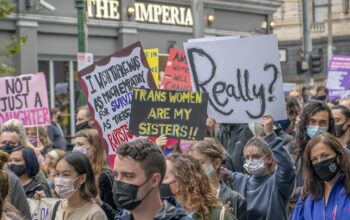“I am not a feminist. I am an intersectional feminist.”
This is how a friend of mine described herself when our conversation one day touched upon women’s rights. To me, this first sounded slightly paradoxical. Wasn’t a movement like feminism supposed to be united in the fight for gender equality? What was the point of separating it into more subcategories?
My friend’s counter-argument was that there is no such thing as just one united kind of feminism as women’s needs differ all over the world. That seemed legit. However, since the term of “intersectional feminism” was new to me, I still didn’t understand what it covers and where it comes from. This is what I aim to do in this article.

The term “intersectional feminism” is defined in different words by different feminist scholars. What unifies them is the emphasis on the fact that a woman is not a universal category and that different women fight different battles all over the world.
Juliet Williams, professor of gender studies at UCLA, puts it this way: “Intersectional feminism is a form of feminism that stands for the rights and empowerment of all women, taking seriously the fact of differences among women, including different identities based on radicalization, sexuality, economic status, nationality, religion, and language.”
Recognizing these differences is crucial, according to Ruth Enid Zambrana, director of the Consortium on Race, Gender and Ethnicity at the University of Maryland.
“Intersectionalism is crucial,” she writes. “How do we begin to disentangle ‘women’ from ‘African American women’ from ‘Puerto Rican’ women from ‘Mexican American women’ from ‘international women’?”
Maybe it is a rising awareness of diversity that have shed more light on the term intersectional feminism the past years and put it on the lips of, for instance, the women protesting against Donald Trump’s inauguration earlier this year.
However, intersectional feminism is not a new concept. It was named already in 1989 by the American professor of law Kimberlé W. Crenshaw. Her definition frames intersectional feminism as “the view that women experience oppression in varying configurations and in varying degrees of intensity […] Examples of this include race, gender, class, ability, and ethnicity.”
So, intersectional feminism is aiming to raise awareness of the different challenges and discrimination women
experience. It stresses that women of different class, ethnicity, sexuality etc. have different experiences and problems.
Back in 2014, the British comedian and feminist Ava Vidal wrote in a column in The Telegraph: “There is no one-size-fits-all type of feminism” as a comment on what she defined as mainstream feminism – “a feminism that is overwhelmingly white, middle class, cis-gendered and able bodied.”
Nasime Naseri, Human Rights-student and volunteer for the Swedish association “Kvinna till Kvinna” (“Woman to Woman”), has similar views as Williams, Zambrana, Crenshaw and Vidal.
“Intersectional feminism, to me, is inclusive,” she says. “This type of feminism considers how women face gender discrimination in multiply different ways, for example being a woman, coloured and lesbian. These factors put in a disadvantaged position compared to white heterosexual women.”
She explains: “For example, people tell me I look exotic and it makes me feel objectified – it’s a word you use for plants or animals, not humans. When people say this, they refer to white beauty standards like I’m not normal.”

When asked if feminism – being the belief that men and women are equal – does not automatically include all types of women, Naseri answers: “Mainstream feminism only focuses on issues based solely on gender. It forgets to consider that for e.g. ethnicity also has an impact on how a woman faces gender discrimination. Intersectional feminism considers this.”
She stresses that she does not consider intersectional feminism an only black women’s movement.
“I don’t identify as an intersectional feminist just because I’m a person of colour,” she states. “Everyone can be an intersectional feminist. I identify as such because of my own experiences and because of seeing how my friends and family face discrimination. By only focusing on one part of a problem, we will not find a solution for everyone despite ethnicity, social group and who they love. By being inclusive and joining together we have more chances for change.”
At the same time, she also rejects that intersectional feminism is separating the whole movement into different categories.
“I don’t see intersectional feminists as a sub-group,” she says. “Intersectional feminism is representing people from different social classes, identity groups and it considers how different people face discrimination. So instead of creating a conflict, I think intersectional feminism, by considering things that the first feminist movement did not, is adding more and making feminism more inclusive.”
According to Ava Vidal’s column, it is necessary for the feminism movement to recognize the intersectional development. Otherwise it can possibly cause a backlash to the whole feminism movement.
“Until the mainstream feminist movement starts listening to the various groups of women within it, then it will continue to stagnate and not be able to move forward,” Vidal writes. “The only result of this is that the movement will become fragmented and will continue to be less effective.”
By Ida Scharla Løjmand
Image credit:
Picture 1: Lindsey Jene Scalera, lincensed under CC BY-NC 2.0
Picture 2: Paul Sableman, licensed under CC BY-NC 2.0










